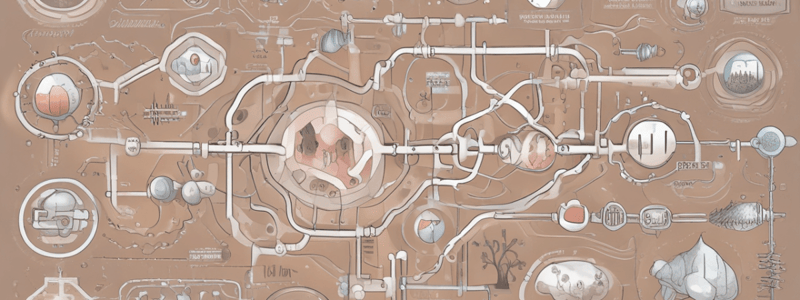Podcast
Questions and Answers
Where can D-amino acids be found?
Where can D-amino acids be found?
- In the glycolytic pathway
- In mammalian proteins
- Only in the liver and kidney
- In plant cells and microorganism cell walls (correct)
What is the main process of amino acid catabolism?
What is the main process of amino acid catabolism?
- Transamination
- Direct oxidative deamination
- Conversion to other amino acids
- All of the above (correct)
What is the product of the reaction catalyzed by glutamate dehydrogenase?
What is the product of the reaction catalyzed by glutamate dehydrogenase?
- α-ketoglutarate (correct)
- Alanine
- Glutamate
- Carbamoyl phosphate
What is the purpose of transamination reaction?
What is the purpose of transamination reaction?
What is the term for the combination of transamination and deamination?
What is the term for the combination of transamination and deamination?
What is formed from the carbon skeletons of amino acids during catabolism?
What is formed from the carbon skeletons of amino acids during catabolism?
Where are nonessential amino acids synthesized?
Where are nonessential amino acids synthesized?
What is the reaction involved in the synthesis of carbamoyl phosphate?
What is the reaction involved in the synthesis of carbamoyl phosphate?
What is the purpose of the urea cycle?
What is the purpose of the urea cycle?
What is the term for the process of amino acid synthesis?
What is the term for the process of amino acid synthesis?
Flashcards are hidden until you start studying
Study Notes
Amino Acid Metabolism and Urea Cycle
- Nutritionally nonessential amino acids are synthesized in the body.
Amino Acid Catabolism
- Amino acids are catabolized through three general processes:
- Specific catabolic pathways
- Conversion to other amino acids, which are then catabolized
- Transamination plus deamination (transdeamination)
Nonessential Amino Acid Biosynthesis
- Nonessential amino acids can be formed from:
- Essential amino acids
- Nonessential amino acids
- Metabolic intermediates
Transamination
- Alanine aminotransferase reaction involves the transfer of an amino group from alanine to α-ketoglutarate, forming pyruvate and glutamate.
Deamination
- Direct oxidative deamination of L-Glutamate occurs through glutamate dehydrogenase.
- Glutamate dehydrogenase is regulated allosterically.
D-Amino Acids
- D-Amino acids are found in plants and cell walls of microorganisms, but not used in mammalian protein synthesis.
- D-Amino acids are present in the diet and are metabolized by kidney and liver.
Amphibolic Intermediates
- Amphibolic intermediates are formed from the carbon skeletons of amino acids.
- Examples include:
- Transamination of an amino acid with α-ketoglutarate
- Direct oxidative deamination of glutamate by glutamate dehydrogenase
Urea Cycle
- Carbamoyl phosphate is synthesized and enters the urea cycle.
- The urea cycle is a critical pathway for removing ammonia from the body.
Studying That Suits You
Use AI to generate personalized quizzes and flashcards to suit your learning preferences.



